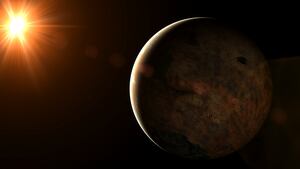Five years ago a very strange object made a very strange journey across the solar system.
Shiny, reddish in color, oblong, somewhere between 300 and 3,000 feet in length and moving at an eye-watering 16 miles a second, the object zoomed into our system and past the sun. When Canadian astronomer Robert Weryk first noticed the thing in a telescope survey in October 2017, it was already on its way out of our system.
Astronomers were baffled by this object, which they named “`Oumuamua.” That’s Hawaiian for “scout.” No one knew for sure what `Omuamua is—or isn’t.
Just one leading scientist was willing to say what others may only have been thinking. `Oumumua’s speed, course and shape were possible signs it’s an alien craft, according to Avi Loeb, a Harvard physicist. “The possibility of an artificial origin for `Oumuamua must be considered,” Loeb wrote in a hallmark 2021 study.

The oblong-shaped ’Oumuamua was first discovered in 2017.
dottedhippo via GettyLoeb’s position—that we should at least entertain the possibility that `Oumuamua is a spacecraft and investigate accordingly—has been controversial, to say the least. Now, a Chinese team is trying to dismantle one key part of Loeb’s argument: If `Oumuamua is an alien ship, it might be propelled by a super-thin light-sail that captures particles from stars.
There’s no sign of a sail in the scant data we have on `Oumuamua, the Chinese team asserted in their own peer-reviewed study, which has been accepted for publication in the journal Astronomy and Astrophysics and appeared on-line on Wednesday. “We conclude that the possibility of `Oumuamua being a light-sail is extremely unlikely,” Shangfei Liu, an astronomer at Sun Yat-sen University in Zhuhai, China, told The Daily Beast.
It should go without saying that Loeb disagrees. “There are a few points that the authors have overlooked,” Loeb told The Daily Beast.
The argument from Shangfei and his colleagues boils down to this: Lightsails, which capture photons the way ships’ sails capture wind and are an increasingly popular way of propelling spacecraft we build here on Earth, tend to be big square things that reflect a lot of light or very little light. It all depends on the angle to the observer as well as how much the craft they’re attached to spin.

Avi Loeb believes that a solar sail (left) could be the reason why the asteroid moves at such high speeds.
Mark Garlick/Science Photo LibrarySo as `Oumuamua streaked across the solar system, it should have been really bright at some points—and all but invisible at others. And while `Oumuamua did get brighter and darker from our point of view on its weird journey, it didn’t get bright enough, Shangfei said. “If it was a lightsail, the brightness variation should be much larger.”
But there’s another explanation for `Oumuamua’s relative dimness, Loeb said—and it’s the shape of a possible sail. The Chinese scientists assume that, if `Oumuamua were a lightsail craft, it would have a flat sail. A flat sail would reflect more light at its brightest moments than, say, a concave sail.
But the sail “need not be flat,” Loeb explained. He pointed out that he’s been working with the Breakthrough Initiative, a science startup founded by Russian-Israeli billionaire Yuri Borisovich, on umbrella-shaped lightsails as part of the initiative’s Starshot space-probe project.
The whole argument over the shape of a possible sail might actually be moot. `Oumuamua could be a spacecraft “in other forms,” Shangfei conceded. In other words, it might not have a sail at all—and might instead rely on some other kind of propulsion system.
Astronomers generally believe that `Oumuamua—assuming it is a spacecraft—would have a lightsail because, in our own experience, a sail is the best way for a craft to build up a lot of speed as more and more photons pile on. There aren’t a lot of other techs we know about that could easily explain `Oumuamua’s quick pace across our system.
But it’s never safe to assume aliens would take the same approach to spacecraft design that we would. “The chances of alien civilizations possessing much more advanced technology than us is quite likely, in my opinion,” David Specht, an astronomy researcher at the University of Manchester, told The Daily Beast.
If `Oumuamua is an alien ship and doesn’t have a sail, there are still two problems. One that undermines Loeb’s assumptions. And another that undercuts the Chinese team’s views.
The problem for Loeb is that our observations of the speedy object clearly showed something reflecting sunlight at odd angles during its journey past the sun. If `Oumuamua is a ship but that reflective thing’s not a sail, what exactly is it?
Loeb has a theory: Maybe `Oumuamua was damaged. The reflective thing “may not be a sail at all, but just a surface layer torn apart from a bigger object.”
The problem for Shangfei and his colleagues is explaining how `Oumuamua picked up such high speed if it doesn’t have a sail—and in fact isn’t a possible alien craft of any kind. They, like Loeb, have theories. Maybe `Oumuamua, whatever it is, is venting velocity-inducing gas like some comets do. “We believe it can be explained by some natural phenomena,” Shangfei’s team wrote.
As the mystery surrounding `Oumuamua deepens and more scientists get involved, there are at least two things everyone agrees on. For one, we don’t have enough data to say for sure what `Oumuamua is. Also, we should be ready—with more telescopes, better mathematical models and maybe even special space probes—the next time something like `Oumuamua streaks across the solar system.
Hopefully then we can say for sure whether the object has a sail, thus making it (almost certainly) an alien craft. “With [the] help of a huge amount of highly accurate observation data in the future,” Shangfei and his colleagues wrote, “we will be able to identify the lightsail.”








